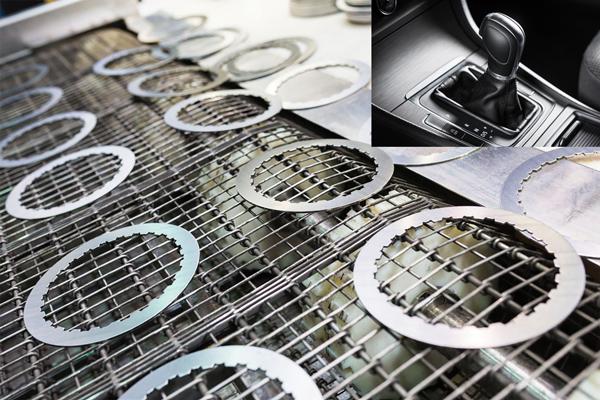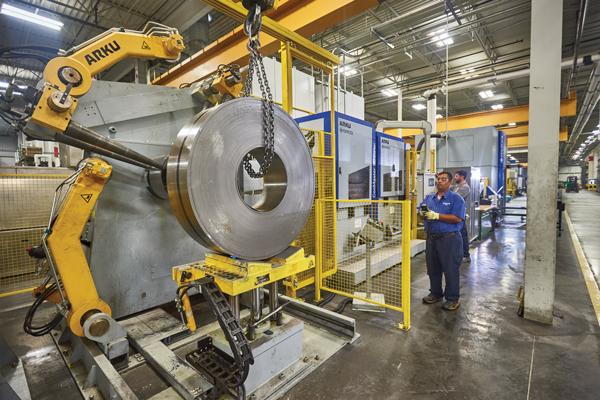Contributing editor
- FMA
- The Fabricator
- FABTECH
- Canadian Metalworking
Categories
- Additive Manufacturing
- Aluminum Welding
- Arc Welding
- Assembly and Joining
- Automation and Robotics
- Bending and Forming
- Consumables
- Cutting and Weld Prep
- Electric Vehicles
- En Español
- Finishing
- Hydroforming
- Laser Cutting
- Laser Welding
- Machining
- Manufacturing Software
- Materials Handling
- Metals/Materials
- Oxyfuel Cutting
- Plasma Cutting
- Power Tools
- Punching and Other Holemaking
- Roll Forming
- Safety
- Sawing
- Shearing
- Shop Management
- Testing and Measuring
- Tube and Pipe Fabrication
- Tube and Pipe Production
- Waterjet Cutting
Industry Directory
Webcasts
Podcasts
FAB 40
Advertise
Subscribe
Account Login
Search
Tier 1 manufacturer flattens dual challenges with tandem coil leveler line
When flat is critical, coil leveling is too
- By Kate Bachman
- July 30, 2019
- Article
- Bending and Forming

Maintaining extreme flatness is mission-critical for transmission components to ensure smooth shifting from gear to gear. This has become increasingly important as transmissions are made with more gears.
The word flat often has a negative connotation. In the financial industry, for example, a flat ROI or flat GDP indicates a lack of progress.
However, in certain automotive parts, such as a transmission clutch plate or a seat adjustment lever, the flatter, the better. Flat translates to smooth. A flat part facilitates a smooth transition from gear to gear, or an easy seat adjustment.
For Tier 1 automotive supplier Feintool, which manufactures those drive transmission and seat components, “flat” is where it’s at. A very flat part starts with very flat coil. This necessitates coil leveling, according to Feintool Executive Vice President Sales and Marketing Lars Reich.
But achieving extreme flatness in a wide coil used in the process is challenging, he said. Feintool needed a coil leveler that could handle the job.
Automotive Tier Supplier Fineblanks Its Way up the Supply Chain
Feintool can probably be excused for calling itself the market leader in fineblanking, a precision stamping process. The Swiss manufacturer with U.S. headquarters in Cincinnati is a fineblanking press manufacturer, as well as a Tier 1 and Tier 2 automotive supplier.
The fineblanking process involves three forces, which distinguish this technology from other punching or cutting processes. It results in a full-sheared edge that is smooth, crack- and burr-free. Additional finishing on the edges contours generally is not required, according to the company. The component itself is flat and level because of the secure clamping process.
The global company with 15 production plants around the world is a publicly traded company with around 3,000 employees and $700 million in annual sales. Two plants are in North America, in Cincinnati and in Nashville. The two plants combined produce almost 1 million automotive components every day.
Roughly 96 percent of its business comes from automotive. “We supply transmission parts directly to everybody in North America—including several OEMs. On the seating side we are Tier 2 mostly. We supply to all major players in North America and then they supply to the OEM,” Reich said.
Transmission Parts. One part family the company specializes in are transmission components, such as clutch plates, Reich said.
On vehicles with combustion engines, great potential for reducing fuel consumption lies in improving the drivetrain. Complex fineblanked and formed components are essential for efficient and modern automatic transmissions and hybrid drives, with new generations of gearboxes that are increasingly compact, light, and accurate, according to the company.

Modern seat adjuster mechanisms consist almost entirely of fineblanked components. The complex geometries, short runs, and use of high-tensile steels require precision in the tool and production technology.
Seating Components. Another part family Feintool makes are seat adjustment components. Modern seat adjuster mechanisms consist almost entirely of fineblanked components, the company states. The complex geometries, short runs, and use of high-tensile steels require precision in the tool and production technology.
“These seat adjuster components, such as height adjustment levers, seat rake adjusters, and reclining mechanisms, are among our core competencies,” Reich relayed.
Consumers are demanding more convenient adjustment mechanisms, he added.
Why Parts Need Flatness
A critical aspect of both transmission clutch plates and seating mechanisms is that the parts be extremely flat, according to Reich. “Everything starts with the flat part.”
Why is flatness so critical? “The function itself in the transmission demands a very high flatness. If they’re not flat, the whole shifting of the transmission will not work as smoothly as we drivers have come to like it. The part really needs to be flat in order to work properly,” Reich said.
Since modern vehicles are being designed with more gears in the transmission to achieve better fuel efficiency, manufacturing parts for those vehicles has not exactly gotten easier, Reich said. “If you see what happened the last years, cars went from five-speed to six-speed transmissions and now have eight-, nine-, and 10-speed transmissions.
“With more gears in transmissions, the demand on the transmission parts really has only increased. With more gears, there are so many more working mechanisms, but there’s no more space in the transmission. It’s very cramped in there.”
The flatness requirements have increased with the shifting quality, he added. “Consumers have gotten used to what a good transmission should feel like and are not willing to accept jerky gear shifting. That made the requirements more stringent.
“Everything needs to work perfectly in those transmissions,” Reich emphasized. “And that’s why everything starts with the flat part. If you don’t have a flat part, you don’t have a product basically.”
Coil Flatness Challenge: Double Output, Double Trouble
Because the company produces a massive volume of transmission and seating adjustment components, it stamps them two-out to double output. But that means stamping the parts out of wide coil. Therein lies another problem: Coil flatness is hard to achieve in a very wide coil.

It’s very difficult to get the bow out of the coil, and it’s difficult to find a coil leveler for wide material that can make the material flat enough. To resolve both problems, Feintool installed an ARKU tandem leveler system to effectively level wide coil from 1 to 12 mm thick.
“If you have a narrow strip of a coil, it’s not such a problem to get the perfect flatness result. But if you run two-out tools, that means you make two parts per stroke, so you have to have a wide strip.” The coils the manufacturer uses can be up to 16 inches (400 millimeters) wide.
“It’s very difficult to get the bow out of the coil—the crown, we call that. That occurs front to back of the coil. So it’s difficult to find a coil leveler for wide material that is able to make the material flat enough for the part quality we need,” he continued.
Tandem Leveler Doubles Down to Straighten Wide Coil
Feintool purchased an ARKU tandem leveler/decoiler. There are two levelers in serial. Coil runs through a first set of rollers and then through a second set.
The two levelers have rollers with different diameters. In this case, the first leveler has about 3-in.- (80-mm-) diameter rollers and the second leveler has roughly 2-in.- (50-mm-) dia. rollers. When thicker materials are run through, the first leveler is used and the second leveler is opened up and is idle. When thinner materials are run, the second leveler is used and the first leveler is opened up and is idle. For materials in the middle range, the two levelers can be operated in a sync mode.
The machine has straightened and leveled the wide coils effectively, Reich said.
Range and Material Thicknesses. Reich said that the leveler allows the company to meet its needs to stamp various material thicknesses. “We run many different parts families. We need the flexibility to run almost any product. We get orders for a combination of thick and thin parts. We cannot control the thickness; that’s the requirement of the customer. If a customer needs a part 2 mm thick, I need to be able to meet that demand.
“Now we have one machine that covers up to 4-mm material thickness and then the second machine levels 4 to 12 mm. By having the tandem, we can basically work the full spectrum of materials, from 1 to 12 mm. It gives plus full flexibility.”
Maximize System Capacity. Reich said that the tandem leveler system allows the manufacturer to maximize the full capacity of its powerful and expensive fineblanking press.
“That 880-ton fineblanking press is a $4 million piece of equipment. So you don’t want to limit the capabilities of your fineblanking press by putting a single decoiler/leveler that can handle only 1 mm to 4 mm in front of it.
“So that leveler investment lets us fully utilize our press.”
Same Footprint. Some cost and space savings were realized also because the company can use only one decoiler. Each leveler can be run independently. “We can use one or the other leveler all with one decoiler. So it’s the same footprint.”
Investment
Reich said that it was very important to the company to choose well in selecting the type of equipment and brand. Some leveling equipment it had used in the past could not flatten the steel to the degree of quality needed.
“You cannot afford to experiment. You cannot afford to choose the wrong machine—timewise or moneywise,” he said. “These precision levelers are a big investment. Furthermore, custom machines can have long lead times, so it’s more expensive if you find out about a mistake later. So that’s why we were willing to spend a little bit more on coil leveling equipment so that we could have a product that could fulfill our stringent flatness requirements.”
Feintool, 11280 Cornell Park Drive, Cincinnati, OH 45242, lars.reich@feintool.com, 513-247-4090, www.feintool.com
ARKU Inc., 11405 Grooms Road, Cincinnati, OH 45242, info-us@arku.com, 513-985-0500, www.arku.com
About the Author

Kate Bachman
815-381-1302
Kate Bachman is a contributing editor for The FABRICATOR editor. Bachman has more than 20 years of experience as a writer and editor in the manufacturing and other industries.
Related Companies
subscribe now

The Fabricator is North America's leading magazine for the metal forming and fabricating industry. The magazine delivers the news, technical articles, and case histories that enable fabricators to do their jobs more efficiently. The Fabricator has served the industry since 1970.
start your free subscription- Stay connected from anywhere

Easily access valuable industry resources now with full access to the digital edition of The Fabricator.

Easily access valuable industry resources now with full access to the digital edition of The Welder.

Easily access valuable industry resources now with full access to the digital edition of The Tube and Pipe Journal.
- Podcasting
- Podcast:
- The Fabricator Podcast
- Published:
- 04/16/2024
- Running Time:
- 63:29
In this episode of The Fabricator Podcast, Caleb Chamberlain, co-founder and CEO of OSH Cut, discusses his company’s...
- Trending Articles
Tips for creating sheet metal tubes with perforations

JM Steel triples capacity for solar energy projects at Pennsylvania facility

Are two heads better than one in fiber laser cutting?

Supporting the metal fabricating industry through FMA

Omco Solar opens second Alabama manufacturing facility

- Industry Events
16th Annual Safety Conference
- April 30 - May 1, 2024
- Elgin,
Pipe and Tube Conference
- May 21 - 22, 2024
- Omaha, NE
World-Class Roll Forming Workshop
- June 5 - 6, 2024
- Louisville, KY
Advanced Laser Application Workshop
- June 25 - 27, 2024
- Novi, MI


























